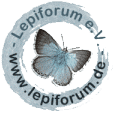

 +2Kontinente:EUAS
+2Kontinente:EUAS2. Diagnose
2.1. Erstbeschreibung
3. Weitere Informationen
3.1. Andere Kombinationen
- Hydrocampa crisonalis Walker, 1859 [Originalkombination]
3.2. Synonyme
- Parapoynx hebraicalis Snellen, 1880
- Parapoynx myina Meyrick, 1885
- Nymphula incurvalis South, 1901
- Nymphula takamukui Shibuya, 1929
3.3. Faunistik
Die Art ist nicht in Europa heimisch! Goater (1986) schreibt: "One specimen taken in the Enfield nurseries, 25 May 1979. Widespread and common in the Indo-Malayan region." Goater et al. (2005) erwähnen sie im "Appendix: List of acentropine species introduced to Europe by man" mit dem kurzen Text: "One specimen found in Great Britain (Agassiz (1982)). Native to the Oriental Region." Die Art dürfte in Europa zumeist nur in warmen Gewächshäusern leben können. — Agassiz (1982) meldet eine Bestimmungskorrektur an seiner Arbeit vom Vorjahr (Agassiz (1981: 24, pl. 3, fig. 5)). Dr. Wolfgang Speidel, Karlsruhe, habe ihn darauf hingewiesen, dass die 1981 als P. stagnalis gemeldete Art tatsächlich P. crisonalis sei.
(Autoren: Erwin Rennwald und Jürgen Rodeland)
3.4. Literatur
- Agassiz, D. (1981): Further introduced China Mark Moths (Lepidoptera: Pyralidae) new to Britain. — Entomologist's Gazette 32: 21-26, pl. 3.
- Agassiz, D. (1982): Parapoynx stagnalis (Zeller) (Lepidoptera : Pyralidae) : a correction. — Entomologist's Gazette 33: 122.
- Goater, B. (1986): British Pyralid Moths. A guide to their identification. — 1-175 + 8 colour plates (Colchester: Harley Books).
- Goater, B., Nuss, M. & Speidel, W. (2005): Pyraloidea I (Crambidae: Acentropinae, Evergestinae, Heliothelinae, Schoenobiinae, Scopariinae). - In: Huemer, P. & Karsholt, O. (Hrsg.): Microlepidoptera of Europe 4: 1-304.
- Erstbeschreibung: Walker, F. (1859): List of the specimens of lepidopterous insects in the collecton [sic] of the British Museum. Part XIX. Pyralides. 795-1036. London.





